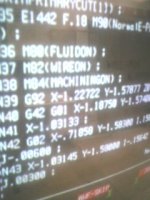asraraleem,
Congrats with your new Makino Wire EDM! I am the EDM Applications Manager at Makino, and I would like to start by asking if you have called into our Technical Support line at 888-MAKINO4 (625-4664)? This will be the quickest and easiest way for you to get in touch with our Applications Department, and we would be happy to assist you with your current issue.
To best answer your question, I would like to understand what material and thickness is being cut, what Machining Method or E-Code settings you are using (such as High Speed or Precision), and where exactly your wire breaks are occurring (how much material is left before dropping the slug). Also, how many hours do you have on your current position of the Energizer Plates, as these should be indexed around 70~80 machining hours. By what means are you holding on to your slug...are you just letting it drop, or are you using some magnets?
As a guess, it sounds like you might have too much flush pressure during your part/slug cutoff (say the last 0.040" of cut length). The flushing might be moving your part around, which can cause wire breaks, but you might also be facing some material stress relieving movement. If you look on the right-side of the OPERATION page, what is the actual flush pressure readings of the Upper and Lower flush pumps, and do you see an orange tab that reads "On", which indicates an issue with flushing? Rather than mess with several E-Code element parameters (such as wire tension, machining power, and flush pressure), the Makino control does provide some convenient functions to help you process your work that are located on the OPERATION screen:
EZ-Cut: This is a slider bar function that allows you to easily change the cutting condition characteristics by (+) or (-) 25% by 5% increments. Each click represents a 5% change to the active Rough Cut E-Code, and the colors on the slider bar change to represent the edits that have been made. More aggressive settings are HOT colors (Yellow, Orange, Red), whereas as SAFE settings are cool colors (Shades of Blue). In your case, you might want to try lowering the EZ-Cut by 10% or 15% in your problem area. This function can also be G-Code programmed so that it can be incorporated into a production program.
CutOff: This is a function that is located on the same tab as the EZ-Cut, and is designed to automatically change the flush and power settings when dropping slugs. The biggest advantage to this function is that is drops the flush levels to a point that will eliminate slug movement, and the machine should just "sing" through the rest of the cutoff/tab section.
I hope that you will find some of this helpful, but if you are still experiencing an issue, please call our Technical Support. Good luck!
-Brian


